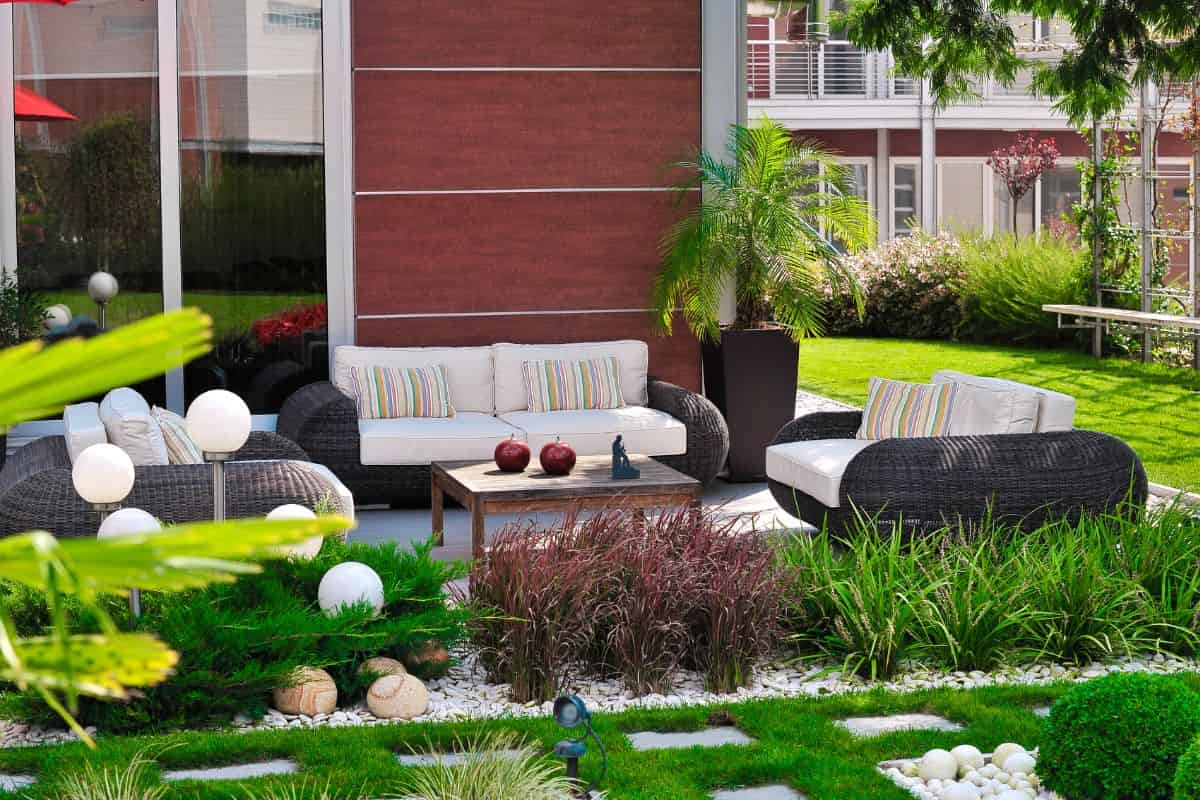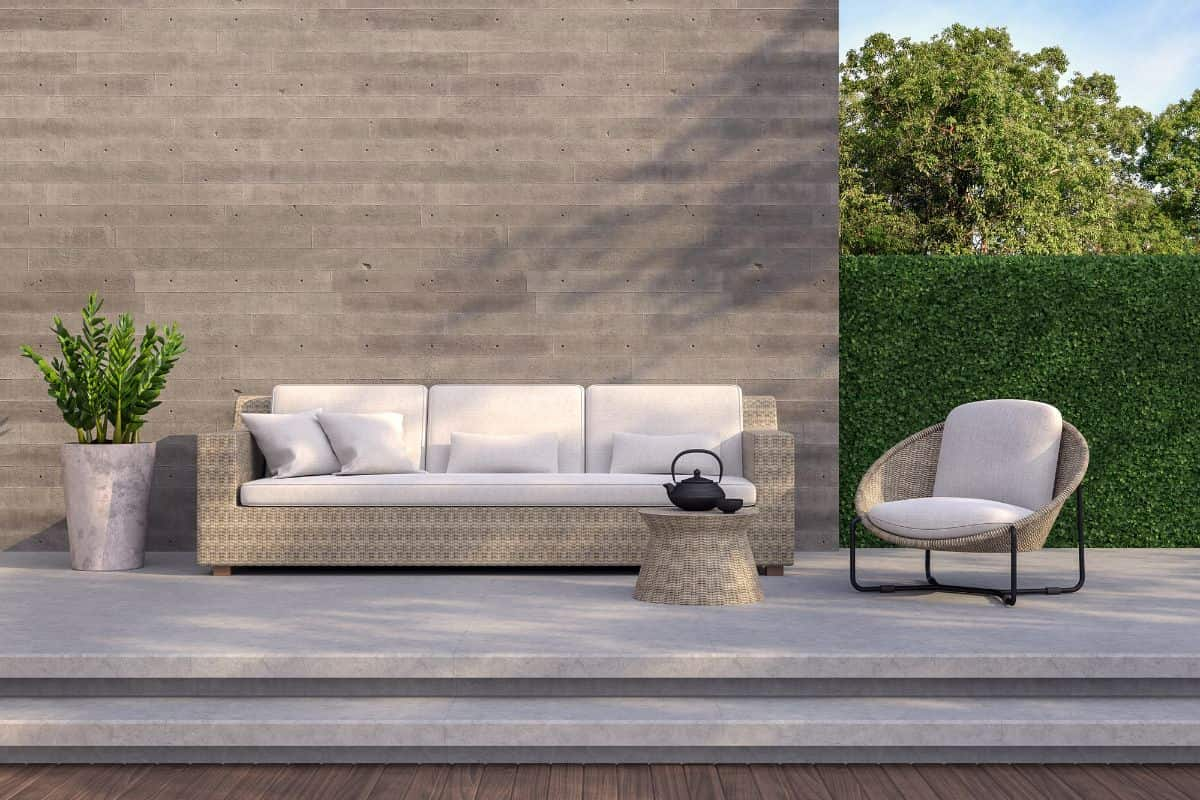



Are you thinking of giving your garden a new style? Would you like to mix light and dark furniture on your terrace but don’t know how to do it without making the space lose coherence?
Don’t worry, with the right tips you can create a cosy atmosphere full of personality by combining your favourite shades. The options are endless: mix dark garden armchairs with a light-coloured table, combine a dark sun lounger with a white or beige parasol…
In this post, we give you the key to combining dark and light furniture in your garden in a balanced way, maximising natural light and highlighting every detail. Read on to find out!
Tabla de contenidos
ToggleFirst of all, let’s look at the benefits of using light furniture on the one hand and dark furniture on the other. Each of the shades offers different advantages that should be taken into account when furnishing the garden.
Decorating with dark furniture – in black, anthracite grey or chocolate brown, for example – has the following advantages:

Decorating with light colours – such as white, beige or ash grey – also has its own benefits:
We have already seen that, whether they are dark or light furniture, both bring advantages to the space, but there are some aspects to consider before combining them:
Now it’s time to see how to combine dark and light furniture so that your garden becomes a cosy space that is perfect for relaxing. For this mix to work well, it is important to follow certain guidelines to ensure that the colours blend perfectly both with each other and with their surroundings.



Balance is key when combining dark and light furniture, so avoid letting one tone completely dominate the space. The idea is for the two tones to complement and not compete with each other.
For example, if you have a set of light-toned furniture, you can incorporate a couple of dark pieces such as a side table or bench to create contrast.
In general, dark colours don’t go well together, so it’s important to choose one shade and use it as a base to integrate light furniture and other decorative elements.
Using several dark tones at the same time can create a confusing and cluttered visual effect, as these colours tend to compete with each other. On the other hand, choosing a single dark shade helps to unify the space and bring coherence to the design.
Another good strategy is to decide which element will be the focal point of the design. A dark table can become the focal point of the garden, surrounded by light chairs or benches to soften the contrast.
Or, conversely, a light sofa can stand out against a dark wooden deck or a brightly coloured pergola.
Decorative accessories are also essential for combining dark and light furniture. Cushions, blankets, outdoor rugs or planters can include patterns or neutral colours that combine light and dark tones.
For example, a cushion with black and white details can act as a visual bridge between a light sofa and a dark table.
The type of material can influence how tones are perceived. For example, a dark wooden table combined with light rattan chairs will create a warm and natural mix.
If you use metal in dark furniture, you can combine it with light textiles to soften its modern or industrial look.
Decorating with light and dark colours can find great allies in the natural elements of the garden. Plants, flowers and even the soil help to integrate both shades in the garden.
For example, a plant with intense green foliage can soften the contrasts between a dark table and light chairs, unifying the design.
Another great alternative can be to divide the space into distinct areas, using furniture in different shades for each area. This technique not only organises the space, but also highlights the purpose of each area.
As an example, you can use dark furniture in a dining area for a formal feel and light furniture in a relaxation area for a more chill out atmosphere.
Grey, beige and other neutral tones can act as an intermediary between black and white shades. Introducing these colours into cushions, rugs and even garden walls will help to visually connect the two extremes.

Combining white furniture and dark wood is one of the most popular trends in both interior and exterior design, given the balance between the purity of white and the warmth of dark wood.
In fact, combining wood and white not only provides an appropriate visual contrast, but also balances functionality and style, helping to create cosy, modern and timeless spaces.
However, decorating with wood and light colours requires a balance that enhances the qualities of both tones without losing visual harmony. To achieve this, start by choosing the predominant colour according to the atmosphere you want to create:
In addition, if you are going to mix white furniture and wood in your garden, you should choose materials that are suitable for outdoors, especially with regard to wood, which should be treated so that it does not deteriorate due to the inclemency of the weather.
Finally, remember to use the vegetation in the garden as a visual bridge: the natural green is perfectly complemented by the contrast between the bench and dark wood, reinforcing the harmony of the space.
As you have seen throughout this post, mixing light and dark furniture in the garden is an excellent idea as long as it is done with planning and balance.
Black and white are easy to combine both with each other and with other tones, creating a dynamic design that, well executed, can be adapted to any decorative style. Moreover, this combination makes the best of both tones: light colours bring freshness, spaciousness and lightness, while dark colours add elegance, depth and solidity.
However, to achieve a good result, it is important to take into account factors such as natural light, the size of the garden and the proportion of the colours. In addition, the use of accessories such as cushions, textiles and decorative elements will help to visually connect the two tones, preventing the design from appearing inconsistent.
In conclusion, combining light and dark furniture in the garden is an effective and stylish decorative strategy, ideal for creating an attractive, balanced and functional garden.
If you still have doubts about how to combine dark and light furniture on your terrace, contact us so we can advise you. At Home Zentrum we will guide you in choosing the garden furniture that best suits your space.



